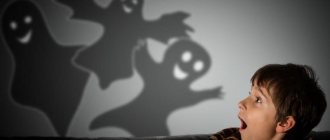In this article we want to consider fear as a unique psychological phenomenon, i.e. talk about its psychological mechanisms, as well as the most famous scientific studies on this issue. Naturally, this material should not be perceived as a full-fledged scientific work - we are only making an attempt to give fear some psychological interpretation.
Additionally, you can read our article “Fear. What should we do with it?”, where we present many interesting scientific facts that reveal the mystery of this mental phenomenon, plus we provide links to useful scientific materials. In general, expand your knowledge, and let this article serve as another coin to add to your knowledge bank.
Fear concept
Currently, there are many definitions of fear. For example, the Soviet and Russian philosopher and psychoanalyst V. M. Leibin defines fear as a mental state that is associated with painful experiences and causes actions aimed at self-preservation.
American philosopher and psychologist William James believed that fear is one of the three most powerful emotions (the other two are anger and joy) and is a basic instinct. The Austrian psychiatrist and psychoanalyst Sigmund Freud defined fear as an affective state consisting of the expectation of some kind of threat; He called fear of something specific fear, and pathological fear - phobia.
Austrian psychologist and psychiatrist Alfred Adler believed that fear is the result of the suppression of aggressive drive, which plays a vital role in a person’s life. According to psychologist Grace Craig, fear is an emotion that is avoided or minimized by a person, but at the same time, fear, if manifested in a mild form, can encourage a person to learn.
German psychologist Erik Erikson interpreted fear as a state of apprehension focused on various threats that are easy to recognize, soberly analyze and adequately resist. According to another psychologist, Dieter Eike, fear is a state of mind, and every person can observe it almost every day. The essence of this state is that a person, to one degree or another, realizes that he is in danger.
American psychologist Carroll Izard believed that fear is a strong emotion experienced as anxiety or apprehension. Moreover, this is one of the most dangerous emotions, which can even lead to death. And for the famous Russian academician I.P. Pavlov, fear was a manifestation of a natural reflex and a passive defensive reaction based on the instinct of self-preservation.
The famous Russian psychologist E.P. Ilyin considered fear as an emotional state that reflects the protective biological reaction of an individual at the moment of experiencing an imaginary or real danger to well-being and health. In the understanding of another domestic specialist, psychologist A.I. Zakharov, fear is one of the fundamental human emotions that arises in response to a threatening stimulus.
Let's consider another point of view: the Soviet psychologist L. S. Vygotsky proposed to understand fear as a very strong emotion that has a serious impact on human behavior, as well as on his perceptual and cognitive processes, limiting thinking, perception and freedom of choice.
But to one degree or another, not only the understanding of fear by various scientists and specialists is diverse, but also the approaches to its study. We definitely need to get to know them so that the phenomenon of fear becomes more understandable to us. Next, we will talk about the main theoretical directions in the study of fear.
Types of fear
The feeling of fear has many classifications: according to personality type, degree of severity and consequences. Any species does not go unnoticed.
Types of fear:
- Social. These are strong, fixed fears driven by environmental conditions that are only getting worse. Fear of people's opinions, low self-esteem, lack of strength to defend one's opinion - all this is a manifestation of social fears. They begin early in life or in adulthood. Fear develops gradually.
- Biological. This is a normal reaction of the body to a difficult situation or threat. At night, biological fears arise as a reaction to nightmares - the patient often complains: “I wake up in the middle of the night and can’t sleep from anxiety.” People of any age and gender suffer from such fear. The absence of a negative reaction is a pathology.
- Existential. These are fears that develop around a certain situation. They are individual and specific. The main enemy for a person in such a situation is personal experience that he cannot let go of. More often, middle-aged people with extensive life experience who experience suppressed fear suffer from this type.
- Children's. In a child's body, unreasonable fear or anxiety arises due to a real threat. A psychosomatic reaction is often observed when physiological symptoms appear due to mental disorders.
Asthenic disease (syndrome) is a disorder of mental function when a person quickly gets tired and cannot recover. Fear enhances the complex state of the patient, who experiences terrible fear from everything that happens to him. Lack of high stress resistance leads to the development of concomitant diseases. The patient's chart is not complete without neurological symptoms.
Determining the cause of an atypical or irrational reaction helps to avoid the development of such diseases.
Directions for Fear Research
There are three fundamental psychological approaches to the study of fear: psychoanalytic, behavioristic and existential approaches. Let's talk about each of them separately.
Psychoanalytic approach
As you yourself understand, the main representative of this trend was Sigmund Freud. In his view, fear develops in close connection with the system of the unconscious and libido - the energy of mental drives. Libido turns into fear through repression - repressed sexual desires take on the form of fear, and this is neurotic fear.
While studying phobias, Freud divided the neurotic process into two phases. At the first stage, sexual desires are repressed and translated into fear, correlated with an external threat. On the second, a defense system is formed that prevents a collision with this threat, and repression is an attempt by the “I” to escape from sexual desires.
In the case of other neurotic diseases, other defense systems are activated to counter the possible development of fear. But, be that as it may, it is the problem of fear that plays the main role in the psychology of neuroses in general.
In his work “Beyond the Pleasure Principle,” Freud notes that the terms “fear,” “fright,” and “afraid” are mistakenly considered synonymous. Distinguishing them from the position of external danger, Freud says that fear, in his opinion, is a certain state of anticipation of a threat or preparation for it, even if it is unknown.
Fear implies a specific object that is feared, and fear is a reflection of a moment of surprise and a state that occurs in the event of danger, when the individual is unprepared for it.
In the book “Inhibition, Symptom and Fear,” also devoted to the topic of fear, Freud emphasizes that the danger that serves as its basis comes from an external object, and neurotic danger is produced by the demand of the drive. However, the requirement of attraction is not something far-fetched, but quite real, and therefore neurotic fear has very real foundations. This suggests that the relationship between neurosis and real fear is explained by the defense of the “I”, because it reacts to the danger posed by drive.
From Freud's point of view, the demand of the drive often turns into an internal danger for the reason that its satisfaction can provoke external danger. At the same time, real danger can become significant for the “I” only if it turns into an internal experience.
Already in his later work, “The Ego and the Id,” Freud says that the “I” is endangered on three sides, and it may well be overcome by a triple fear - the real fear of external reality, the fear of conscience of the “Super-Ego” and the neurotic fear of “ It".
Freud tried to structure the psyche, as a result of which he came to a psychoanalytic understanding of the fact that the unconscious “It” is not afraid, because unable to judge threat situations. It is the “I” that serves as the focus of fear. And it’s not just that the scientist claims that the “I” is a genuine source of fear, and due to the presence of three dangers, it forms the “flight reflex.” As a result, neurotic symptoms and defense mechanisms are formed, leading to the emergence of phobias.
Later, the American psychoanalyst Karen Horney began to develop some of Freud’s ideas, but she also introduced a lot of new things into understanding the nature of fear and anxiety. In her opinion, the cause of all fears is unresolved conflicts. And in addition to this, she sees the reason in social factors that give rise to intrapersonal conflicts, as well as in cultural values.
No less interesting are the views of other representatives of the psychoanalytic approach to the study of fear, such as P.M. Jacobson, S. R. Rogers, E. G. Shekhtel, D. Rapaport, M. S. Neimark. If you are interested in this direction, be sure to check out their works. We also recommend reading our articles related to the psychoanalysis of Sigmund Freud - “Freud’s Psychoanalysis in 5 Minutes” and “Ego, Superego and Id in Psychoanalysis”.
Behavioral approach
The founder of behaviorism, American psychologist John Watson, identified several stimuli that activate fear. These are blows and jolts at the moment of falling asleep, a sudden loss of support and sudden loud sounds. All other stimuli that cause fear, in his opinion, can be considered a combination of the above.
Initially, a person has unconditional, i.e. innate fear reactions. But in the process of life, new stimuli are formed that cause fear. To prove this, Watson cited the results of his research, according to which such things as fire, darkness, animals, etc. They do not cause any fear in infancy.
As Watson carried out his research, he became interested, among other things, in the possibility of forming a fear reaction towards objects that had not previously caused fear. Together with his wife Rosalia Reiner, the scientist studied the possibility of forming an emotional reaction of fear in an 11-month-old child. A white rat was taken as a frightening stimulus, and previously the baby had calmly played with this rat and was in the crib with it.
Before the experiment, the boy was not afraid of rats, and no deviations were observed in his development. He was also not afraid of rabbits, dogs, monkeys, or other animals. At the time of the experiment, there were three other children in the hospital, and none of them were afraid of anything like that either. The experiment itself was needed by scientists to answer three questions:
- Is it possible to instill a fear of animals in an infant if the animal is shown together with a fear-inducing stimulus?
- Will the child be afraid of other animals?
- How long will the acquired fear last?
The fear-inducing stimulus in the experiment was a loud sound - behind the baby's back, the scientists were banging on an iron plate with a hammer. During the first session, the plate was struck twice each time the child touched the albino rat. And after two repetitions, the baby began to avoid touching the rat.
A week later the experiment was repeated. The plate had already been hit five times, and the rat was simply placed in the crib with the child. The baby showed an avoidance reaction and began to cry as soon as he saw the rat. And five days later, scientists decided to test whether the fear reaction would transfer to other objects.
As a result, Watson noted the child's fear at the sight of a dog, a rabbit and a fur coat. The child also tried not to come into contact with the Santa Claus mask and ordinary cotton wool. Considering that there were no loud sounds when these objects were demonstrated, the scientist decided that the reaction was transferred to objects similar to the white rat.
As a result, Watson drew analogies and concluded that many fears, anxieties and aversions in adults are formed in the first years of life. A little later, the researcher discovered that acquired fears are characterized by high persistence and ease of transfer to similar situations and stimuli. And to eliminate fears, long-term therapy is necessary, but only one fear can be weakened, and reactions to related situations and stimuli remain the same.
Another scientist who used a behavioral approach to the study of fears was the American psychologist Burres Frederick Skinner, who developed the theory (model) of operant conditioning of fears. The essence of this model is that fear can be generated, maintained, and strengthened by reinforcement that occurs after fearful behavior. Reinforcement can be either positive or negative.
Positive reinforcement can be illustrated this way: a child can be afraid of something and run to his parents so that they protect him, and they give him protection, affection and care. Subsequently, in any similar situation, the child increasingly begins to turn to his parents, thereby using a strategy of escape from the frightening stimulus.
In some cases, the child may even resort to feigning fear in order to get reinforcement again. In this case, fear has a so-called hidden benefit. And most of all, such fears are reinforced if fear is the only opportunity for a child to receive parental attention.
Given that fear is a negative stimulus, any person will strive to prevent it. And every time this happens, negative reinforcement occurs. As a result, fear reinforces itself. This can explain that fear is very difficult to suppress, even if there is no conditioned stimulus.
If you are interested in the ideas of behaviorists, you can also pay attention to the works of other representatives of this direction of psychology - E. Thorndike, W. Hunter, K. Lashley, A. Staats. By the way, read our article “Behaviorism: main provisions, representatives and directions,” and we move on.
Existential approach
The existential approach, also called existential logotherapy, was proposed by the Austrian psychiatrist and psychologist Viktor Frankl. He presented the mechanism of formation of the fear reaction as follows: a person is afraid of some phenomenon and an expectation reaction appears, i.e. fear that this phenomenon will be realized.
Further, symptoms of the expected condition may appear, which intensifies fear. This closes the chain of tension: the fear of expecting danger becomes stronger than the fears associated with the danger directly. And a person begins to react to this fear by withdrawing from reality.
Fear often appears when something related to it happens, when a person experiences corresponding experiences. For example, a person is about to speak in public, he is nervous and notices that he is “shaking.” When he has to perform again, a person's anxiety begins to be supplemented by the fear that he will start shaking again, and, of course, this is what happens.
As a result, the person begins to avoid speaking in public, because he thinks that he will shake again and he will not be able to suppress and hide it. And if fear is not overcome in a timely manner, the situation may get worse. Thus, a phobia appears, leading to a constant repetition of symptoms, as a result of which the original fears become stronger.
Based on this, Frankl proposed using self-detachment, the ability for which is most clearly manifested in humor. With the help of humor, a person can distance himself from absolutely everything, including himself and his experiences, which means he is able to begin to control himself and the situation.
According to Frankl, fear is a biological reaction that allows one to avoid real or imaginary situations of danger. And if a person himself begins to actively look for situations of fear, he will learn to act, bypassing fear, which will make the latter disappear, because “atrophies” from not being “used.”
Frankl developed corrective methods for dealing with fears. One of them was the method of paradoxical intention (initially proposed by A. Adler), which assumes that the psychologist actually directs the “patient” to his fear. The paradox lies in the fact that a person does not run away from fear, but goes towards it.
It is appropriate to give an interesting story here: one day the parents of a 9-year-old boy who kept wetting the bed came to Frankl. No amount of threats or punishment from parents helped. Then the scientist made an unexpected offer to the boy: from now on, every time he wets the bed, he will give him 50 cents.
The boy was happy and began to hope that he would be able to make money from his problem. He began to deliberately do everything he could to make the bed wet, but nothing worked. As a result, the neurotic symptom disappeared, and disappeared at the very moment when the desire to repeat this symptom began to prevail in the child’s consciousness.
Frankl suggested doing the same with other fears: if a person is afraid of closed spaces, he must force himself to be in such a space; if he is afraid of frogs, he must force himself to pick up and hold the frog, etc. And with a long-term and/or systematic approach to a person’s fear, he will be able to successfully overcome it.
These are the main ideas of Viktor Frankl. If you want to get to know them better, it is worth studying the work of this person. In addition to the three approaches considered, two more can be distinguished:
- Sensual approach. A person’s assessment of a situation of fear occurs on the basis of sensations. Main representatives: I. B. Titchener, D. Lange, E. Claparède, V. James.
- Cognitive approach. A person’s idea of fear is formed on the basis of intellectual processes. Main representatives: M. S. Singer, R. W. Leeper, R. S. Lazarus, M. Simon.
It is up to you to draw conclusions, and you can only draw them if you are an expert in this field. We will not insist on accepting any one point of view, but will try to bring all of the above to a single denominator.
Causes of fear
Fear can last from a few minutes to several hours. Fear can turn into a panic attack, which leads to seizures or hysteria.
The main reasons for the appearance of a negative reaction:
- low resistance to stress and prolonged stress;
- increased sensitivity;
- mental disorders;
- consequence of childhood trauma.
Every fear has a reason - hidden or obvious. Hidden reasons include childhood trauma: violence, lack of love and support, feelings of rejection or depression, which are based on a number of other reasons (self-doubt, weak psycho-emotional defense).
Consequences of fear
Every negative emotion has its consequences. Strong internal tension, uncertainty, seeking salvation or protection - all these reactions force a person to avoid threats in the future. But the problem of personality is not in the imaginary threat itself, but in how a person sees the danger. Anyone who hides from fear and any irritant is in a constant state of stress. Chronic stress does not allow strengthening the defense of the psyche, and over time, new irritants and new dangers appear. The real problem appears when a person does not work with his fears and experiences a feeling of hopelessness and strong negative worries for a long time.
If you doubt the need for professional help, you must adequately assess your own condition and the harm caused. The benefit of fear manifests itself only in improving the quality of life with the understanding that one managed to escape and avoid a real threat.
This is the main difference between fear (as a defensive reaction) and fear (as a manifestation of mental disorders) - after the moment of experience, a person quickly recovers. If he cannot survive what happened and is afraid of repeating the negative experience, mental functions are impaired (negative changes occur in the body).
Summary
The problem of fear, despite the fact that it has its roots in the distant past, remains relevant even in our time, because such a phenomenon as fear will exist as long as man himself exists. Along with the development of society, fear will take on new forms. People will create ever new ways of working with fear.
But fear is not only an inevitability, but also a necessity. You can read why this is so in the article “Fear. What should we do with it?”, but here we’ll just say that initially fear is designed to activate a person’s powers or stop him in moments of danger. But fear also has a number of negative qualities, directing a person’s actions in a completely suboptimal, and sometimes even destructive direction.
Fear is one of the basic emotions of a person, and they are known to have a strong impact on all aspects and aspects of his life. Having been formed in the early stages of human development, fear subsequently accompanies him throughout his life, being an integral part of it.
We feel fear in a variety of situations, but they all have one thing in common - we perceive and feel them when the well-being, peace, security and life of ourselves or our loved ones are threatened. Fear is also involved in the social development of the individual, and in it it acts as a unique means of education, because often regulates behavior.
We also note that impressive research on fear has been carried out by a huge number of scientists, and not only those that we mentioned in the article. Among them are C. Spielberger, B. Sadok, G. Kaplan, S. Kierkegaard, O. Rank, A. Kempniski, H. Heckhausen, C. Rycroft, P. Tiplik, F. Riemann and others.
In this article, we only spoke in general terms about the psychological foundations of the emotion of fear and briefly reviewed the ideas of scientists who have achieved truly impressive results in their research on fear:
- the psychoanalytic approach suggests that the nature of fear is most closely connected with the system of the unconscious;
- the behavioral approach considers fear as a complex of reactions that arise in response to the influence of external stimuli;
- The existential approach interprets fear as a phenomenon that arises at the earliest stage of human development.
However, to understand fear and its nature, it is also necessary to have an idea of its types, which we also talked about in the article “Typology of fears. The most common fears and phobias”, which we strongly recommend reading if the topic of fear is not an empty phrase for you and is of serious interest.
This concludes this article. We wish you never to give in to what frightens you, but also not to forget that healthy fear serves a person only for the good. Good luck and see you again!
We also recommend reading:
- Storytelling
- Some fears of modern man
- Typology of fears. The most common fears and phobias
- "Hot ten" human fears. How to deal with fears?
- Interesting and unusual facts about fear
- Overcoming Fear of Failure
- Systematic desensitization method to combat fears
- Overcoming Fear
- Psychology of fear
- How to overcome fear?
- How to stop being afraid of failures?
Key words:1Psychoregulation
Phobia and anxiety
Phobia is a psychological condition when a person experiences constant fear. In such a state, thoughts and words have the same meaning as a real threat. During an attack, a person experiences fear, and the rest of the time - anxiety. The victim of a phobia is so afraid of repeating a negative experience that he constantly lives in it.
Why is increased anxiety dangerous?
- the body is constantly in a state of stress (psychological tension does not disappear day or night);
- anxiety makes a person paranoid;
- new responsibility causes new stress;
- a person withdraws into himself and into the feelings that he constantly experiences;
- fear makes a person apathetic and tired.
A state of fear and constant anxiety are two factors that affect overall well-being. Against the background of prolonged anxiety, nervousness develops (any form of neurosis). The more stressful situations, the stronger the phobia. The new threat creates the preconditions for the manifestation of mental disorders.
Common Fears
Women's fears rarely differ from men's, because... these are human emotions, independent of gender. If the nature of fears is far-fetched (subjective perception), the person is unable to assess the situation. He lives around fear and does not see the problem with how his reactions manifest themselves.
Psychology assesses the patient’s condition as complex if he is unable to accept the fact of a mental disorder.
The most common phobias:
- fear of death;
- aquaphobia;
- fear of confined spaces;
- Fear of heights.
Whatever the nature of fears, you need to get rid of them. The first sign of the development of a mental illness is inexplicable attacks of severe anxiety.
Fear of death
The phobia is based on the social function of human life: role in society, responsibility, sense of duty. A person is afraid of losing what he has. Fear of death is a phenomenon that occurs regardless of age and standard of living. In adults and older people, fear of death arises due to a number of traumatic events. Often death is presented as an event that threatens, because... it is unknown what will happen after death (this is another type of lost control).
What makes it difficult to get rid of a phobia is the prejudice that adults should not have doubts. A phobia does not allow one to realize oneself - a person is afraid to take risks or overload himself.
Fear of water
Fear develops in early childhood, when the child is guided by instincts. At this age, negative experiences with water are the basis of a future phobia. The influence of fear increases over time, and the patient’s body reacts sharply to any large bodies of water.
There can be many situations when a phobia manifests itself (you don’t have to dive to feel panic). In special cases, a feeling of fear does not allow the patient to take a bath or be near a pond or swimming pool. In the acute form, panic attacks are observed.
Fear of enclosed spaces
With this phobia, a person experiences discomfort because he is closed or locked in, he needs fresh air and space. Such fears manifest an instant reaction in the human body: increased sweating, dizziness, loss of consciousness. Even if there is a logical explanation for fear, it is difficult to argue with such a person because he does not admit his problem.
Social confinement is also scary - in a circle of unfamiliar people, a person becomes cramped and uncomfortable. Dealing with the fear of enclosed spaces is difficult. Usually a psychotherapist works with such problems and helps to get out of a difficult psycho-emotional state correctly.
Fear of heights
Fear of heights prevents many dreams from being realized - looking down from a great height or physically rising above your own height. Phobia does not depend on age, but pathological fear is often caused by childhood trauma or an event that is imprinted in memory. People with this phobia close their eyes when on any height; they need constant contact with a hard, stable surface under their feet.
Treatment of fear
To make fear disappear, modern treatment methods are used. The simplest method is psychotherapy, in which the therapist identifies the cause of the problem and finds out where it “lives.” An individual treatment program is developed for the patient: sessions of psychoanalysis, hypnotherapy and rehabilitation therapy. The simplest method of treatment is to get rid of the wrong thought, which affects the perception of reality and gives rise to a phobia.
Cognitive behavioral therapy is based on reframing the thought that gave rise to fear. The simplest method is hypnotherapy, during which the patient is “planted” with the desired thought.
Major and long-lasting fear can be treated comprehensively. To reduce the general symptoms of a complex mental state, drug therapy is used: tranquilizers, sedatives, sedatives.
Sometimes treatment means more than getting rid of a problem - it is freeing you from irrational thinking. To correct behavior, NLP (neurolinguistic programming) techniques are used. The description of this technique assumes an impact on thinking as an immutable system. Thanks to home exercises, a person learns to control his own mind and correct the mistakes with which he is accustomed to living.
In the treatment of fear, there are only “our” problems - “ours” for the doctor and the patient, “ours” for the fear addict and his family.











